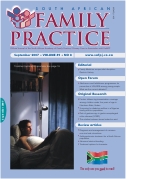Screening for Diabetes Mellitus in a Nigerian Family Practice Population
Keywords:
Diabetes Mellitus, Family Practice, Screening, Glucometer, South West Nigeria
Abstract
Background: Diabetes mellitus is a non-communicable disease with a rising prevalence worldwide. Most of the increase in prevalence is projected to be in the developing countries. As it is recognised that the onset of the disease and its complications predate the symptoms, it is expedient that screening procedures are undertaken to diagnose the disease in the individual as early as possible to minimise the risk of complications. Diabetes mellitus is a chronic disease necessitating life-long therapy, usually with drugs. This creates a life-long financial burden on the family, especially in low socio-economic communities in West Africa, where the majority of the population still lives on less than one dollar a day. This affects the wellbeing of the entire family, hence the need for early detection, prompt and adequate management of the disease and avoidance of its complications. Methods The study is an incidental screening to determine the prevalence of diabetes mellitus, its risk factors and the clinical characteristics of diabetics in a Nigerian family practice population. Four hundred and twenty subjects aged 15 years or older were recruited by systematic random sampling in a family practice in South West Nigeria over a three-month period. Data collected include the subjects’ socio-demographic data, family history of diabetes mellitus and hypertension, and history of tobacco and alcohol use. The subjects’ weight and height were measured and their body mass index (BMI) calculated. Each subject was examined for peripheral neuropathy, lens opacity and hypertension. Fasting blood glucose was measured using a glucometer and urine was tested for albumin. Those with a fasting blood glucose of greater than 6.1 had a fasting blood glucose determination by the standard spectrophotometric method. Results Ten (2.38%) subjects were known diabetics, while 57 (13.6%) were known hypertensives. Ten (2.38%) new diabetics were identified, and 7.5% of the females compared to 5.8% of the males were diabetic. Alcohol intake, obesity, age above 44 years and a positive parental history of diabetes were the significant risk factors (p < 0.01) for diabetes in the study. Proteinuria and peripheral neuropathy were the significant complications (p < 0.01). Conclusions It is concluded that diabetes is a common problem in our practice, with a prevalence of 4.76%, half of which was previously undiagnosed. Alcohol intake, obesity, positive parental history and age over 44 years were the identified risk factors. Peripheral neuropathy, proteinuria and high blood pressure were the identified complications. It is recommended that routine screening of people at high risk of diabetes mellitus in family practice be commenced. The glucometer, a relatively cheap item of equipment in the practice, is a highly useful, sensitive and specific tool for this purpose.
Published
2007-09-04
Section
Original Research
By submitting manuscripts to SAFP, authors of original articles are assigning copyright to the South African Academy of Family Physicians. Copyright of review articles are assigned to the Publisher, Medpharm Publications (Pty) Ltd, unless otherwise specified. Authors may use their own work after publication without written permission, provided they acknowledge the original source. Individuals and academic institutions may freely copy and distribute articles published in SAFP for educational and research purposes without obtaining permission.

